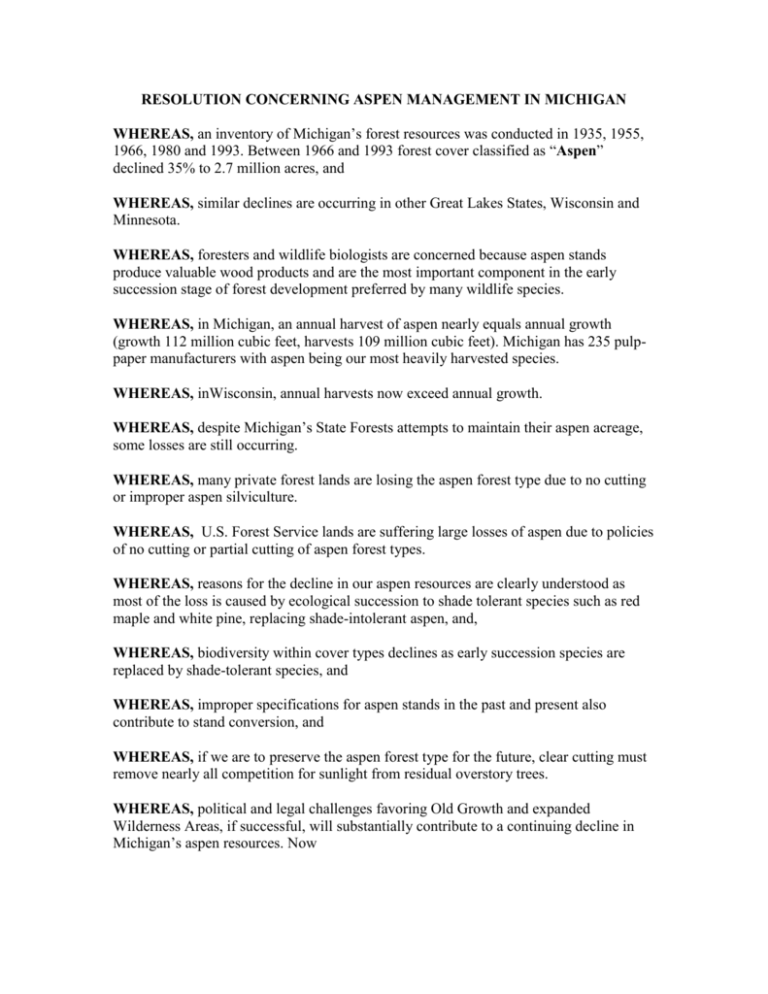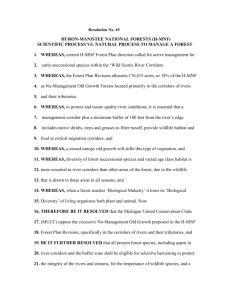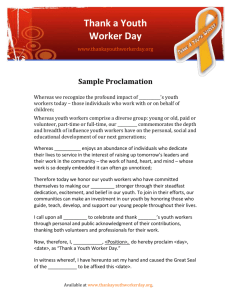RESOLUTION CONCERNING ASPEN MANAGEMENT IN MICHIGAN
advertisement

RESOLUTION CONCERNING ASPEN MANAGEMENT IN MICHIGAN WHEREAS, an inventory of Michigan’s forest resources was conducted in 1935, 1955, 1966, 1980 and 1993. Between 1966 and 1993 forest cover classified as “Aspen” declined 35% to 2.7 million acres, and WHEREAS, similar declines are occurring in other Great Lakes States, Wisconsin and Minnesota. WHEREAS, foresters and wildlife biologists are concerned because aspen stands produce valuable wood products and are the most important component in the early succession stage of forest development preferred by many wildlife species. WHEREAS, in Michigan, an annual harvest of aspen nearly equals annual growth (growth 112 million cubic feet, harvests 109 million cubic feet). Michigan has 235 pulppaper manufacturers with aspen being our most heavily harvested species. WHEREAS, inWisconsin, annual harvests now exceed annual growth. WHEREAS, despite Michigan’s State Forests attempts to maintain their aspen acreage, some losses are still occurring. WHEREAS, many private forest lands are losing the aspen forest type due to no cutting or improper aspen silviculture. WHEREAS, U.S. Forest Service lands are suffering large losses of aspen due to policies of no cutting or partial cutting of aspen forest types. WHEREAS, reasons for the decline in our aspen resources are clearly understood as most of the loss is caused by ecological succession to shade tolerant species such as red maple and white pine, replacing shade-intolerant aspen, and, WHEREAS, biodiversity within cover types declines as early succession species are replaced by shade-tolerant species, and WHEREAS, improper specifications for aspen stands in the past and present also contribute to stand conversion, and WHEREAS, if we are to preserve the aspen forest type for the future, clear cutting must remove nearly all competition for sunlight from residual overstory trees. WHEREAS, political and legal challenges favoring Old Growth and expanded Wilderness Areas, if successful, will substantially contribute to a continuing decline in Michigan’s aspen resources. Now THEREFORE BE IT RESOLVED that the Michigan Resource Stewards oppose all proposal for expansion of Old Growth or Wilderness Areas until an adequate inventory of early succession species present on the affected area has been completed and is considered in the final decision, and BE IT FURTHER RESOLVED, that no land acquired for wildlife purposes with restricted funds should be set aside for “No Management” – either by old growth or wilderness designation – unless land of equal value for wildlife management purposes be identified and formally exchanged, and BE IT FURTHER RESOLVED, that the U. S. Forest Service adopt a policy of minimal loss of aspen forest type and that they correct their silviculture practices to achieve that goal. Submitted by: Michigan Resource Stewards 2003








